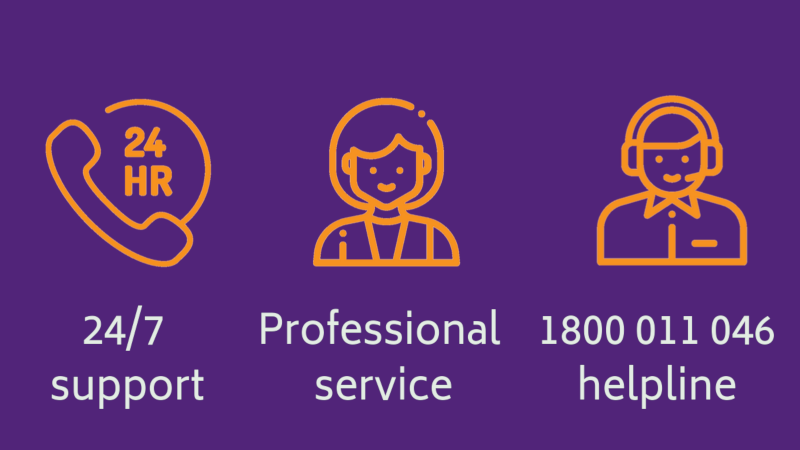About anxiety
Feeling anxious every so often is normal. But if it interferes with your capacity to function normally (or even leave the house), it's time to get help.
Does your anxiety or fear get in the way of your daily life?
Almost everyone feels stressed, worried or anxious sometimes. However, if your anxiety or worry is so severe that it interferes with your ability to cope with daily life, it's time to do something about it.
Do I have a problem with anxiety?
It’s normal to feel a bit anxious in stressful situations like a job interview, if you’re having relationship problems, or if you’ve been unwell or in an accident.
Anxiety linked to a specific event usually passes once the situation is over.
However, some people get so anxious that it’s hard for them to work, socialise or take care of things at home. Their anxiety might be about one or two things in particular, or about life in general.
Symptoms of anxiety may include:
- physical symptoms like breathlessness, racing heart, sweating, trembling, nausea, dizziness
- feelings like being extremely afraid or worried, irritable, the sensation that you’re losing control, or that something terrible is going to happen
- thoughts like thinking the worst or getting wound up about things that haven’t happened
- behaviour like avoiding situations that set off your anxiety.
If you regularly experience some or all of these symptoms and find that they are interfering with your daily life, you might have a problem with anxiety.
Some people who have problems with anxiety turn to alcohol or other drugs thinking they will help them cope. But alcohol and drugs don’t solve the problem, although they can make the problem significantly worse.
There are better ways to deal with anxiety.
Recognise
Dealing with anxiety - Jane's story
Jane is married to Ben, a Rwanda and East Timor veteran.
When Jane met Ben he was extroverted, he got along with everybody and liked going out. Now he won’t leave the house and Jane can’t think of the last time they had people over.
Different kinds of anxiety
'Anxiety' is a general term that describes a range of emotional responses. follow the links below to find out more about some of the most-common anxieties experienced by veterans, and possible treatment options:
-

Panic and agoraphobia
Panic attacks occur when our fight-flight-freeze response is triggered without an obvious external threat. Learning how to relax and control your breathing can help you manage panic attacks. -

Social anxiety
Social anxiety is a crippling fear of becoming the focus of attention, and worry about what other people are thinking about you. Self help and professional care can reduce the impact on your life.
-

Generalised anxiety
If you worry excessively about many aspects of your life, you may have generalised anxiety disorder (GAD). A range of self-help treatment options are available to reduce your anxiety and help you enjoy a less-stressed life. -
 Obsessive compulsive disorder
Obsessive compulsive disorderRepeated unwanted thoughts that cause anxiety (obsessions), and acts or rituals that are performed to lessen that anxiety (compulsions). Find out more about OCD on the Beyond Blue website.
-
 Specific phobias
Specific phobiasSpecific phobia is an irrational fear of a particular situation, activity, animal or object. Common examples include fear of closed spaces, driving, or blood or needles. Read more about specific phobias on the Beyond Blue website.
Self-help
There are a few things you can do yourself to help get back on track. For some people, these strategies will solve the problem. For others, professional help might be needed.
Take action
Relax your body and slow your breathing
Feeling constantly ‘on edge’ leads to muscle tension, fatigue/exhaustion, aches and pains.
These tools will help you to feel calmer and release tension from your body. It pays to work on these techniques, so when you’re starting out, use one or both tools once a day when you are feeling reasonably calm. Once you’ve learnt the skills you can use them more effectively when you feel your anxiety rising.
- The Progressive Muscle Relaxation tool teaches you how to tense and relax different muscle groups in your body. The technique can be helpful if you suffer from backache and tension headaches.
- The Controlled Breathing tool teaches you how to slow your breathing rate. This technique will slow down your heart rate while relaxing your muscles. It tricks your brain into thinking that it's calm and rested.
Because you may not know when anxiety is going to occur, you can also access these tools on your phone through the High Res app.
Use problem-solving strategies
If you’re worried about a particular problem or situation you find yourself in, use the Problem Solving tool to help work through the problem and find the best solution.
When you’re starting out, use the tool to solve a relatively easy problem. Once you’ve learned the skills you can start to apply the problem-solving steps to all sorts of situations as they arise in your day-to-day life.
The better you understand the techniques the easier they will be to use. With practice, they'll become second nature.
Identify unhelpful thoughts
The way you think affects the way you feel. Unhelpful thinking contributes to anxiety symptoms. These can be so intense that they feel completely overwhelming. By the same token, positive self-talk can create a positive mood and mindset.
Challenge Your Thoughts tool to help you identify unhelpful thoughts you might be having about a particular situation.
If you’re in a group you might be overwhelmed by thoughts, like "what if all these people think I’m an idiot when I’m talking?"
You might even be overwhelmed by your anxiety symptoms, like "My heart is beating out of my chest and I’m going to die".
If you feel yourself starting to talk yourself into feeling bad about a problem, use positive talk to change your outlook. Start by telling yourself things like:
- “Even though this is horrible, it's not dangerous or life-threatening.”
- “These feelings will pass.”
- “I’ve survived anxiety like this in the past.”
The Challenge Your Thoughts tool can help you practice spotting unhelpful thoughts so you can replace them with more helpful, positive thoughts.
The aim is to give yourself the headspace to be able to think clearly about your situation and not become overwhelmed by events. Then you can develop a clear path forward.
When you’re starting out it’s a good idea to practice helpful thinking in a situation that is bothering you but isn't too overwhelming. Once you’ve learned the skills you can apply them to more anxiety-provoking situations.
Avoid avoiding
Because anxiety is an unpleasant feeling, it’s easy to want to avoid situations where you might feel anxious.
Avoiding the problem doesn’t build resilience. Instead, it makes it harder to become strong and doesn't give you a chance to learn how to take control of your anxiety.
The more you withdraw, the harder it is to get back to the life you want.
Taking control of anxiety is hard. But don’t let your anxiety take over and stop you from doing things you enjoy, or keep you from achieving your goals.
If you’ve tried different strategies to overcome your anxiety and are still struggling, or your anxiety is very distressing and you need extra help:
See also
-

Stress
The most common reason for seeking Open Arms counselling is stress. High levels of stress and anxiety are a common problem in modern society. -

Counselling
Open Arms can provide individual, couple and family counselling to help improve your resilience, as well as enhance your mental health and wellbeing. Call 1800 011 046 for free and confidential 24/7 support. -
 Group programUnderstanding anxiety
Group programUnderstanding anxietyA program that teaches you strategies and skills for managing anxiety.





